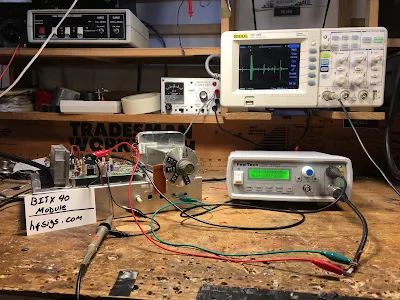Anyway, in an effort to counteract all of this waterfall seduction and to show that us analog HDR guys can go panoramic too, I decided to try to create my own panoramic display without resort to SDR.
Of course, this is a very old technique. It was invented in the 1930s by Marcel Wallace, F3HM. He was the inventor of the Panadaptor which was the forerunner of today's waterfall. Panoramic reception was used by the armed forces during WWII. In 1946 Hallicrafters marketed a Panadaptor for its ham radio receivers (see below).
In figuring out how to do this, I thought back to my use of my Feeltech signal generator to scan the response of a crystal filter. The Feeltech has a very handy sweep feature.
In this case I set up the Feeltech to sweep from 4.85 MHz to 4.75 MHz in one second. With the 12 MHz IF of the BITX40 module, this would result in a sweep from 7.150 to 7.250 MHz.
The sweeping Feeltech just replaced the VFO on my BITX. I hooked up the Rigol oscilloscope to the audio output of the BITX. I set the horizontal scan rate at 100 ms per cm. This would have the trace go across the whole screen in 1.2 seconds.
After a bit of fiddling, I could see signals on the 40 meter phone band. But my display would kind of drift along the screen making it hard to know the frequency of the signals I was seeing.
Alan Wolke W2AEW provided the solution. He advised me to put a big stable signal at 7.150 MHz near the input of the BITX, then use this strong signal to trigger the 'scope scan. The HP8640B signal generator that Steve Silverman gave me (and that Dave W2DAB picked up for me in NYC) provided the triggering signal.
I put a piece of tape across the bottom of the scope display to calibrate the display. See video above.
It works! It is not as cool as the SDR waterfalls, and it does not convey nearly as much information, but it was a fun project.



A simple log.-detector like the AD8307 could improve the dynamic range, which is somehow limited with the envelope displayed.
ReplyDeletePeter/DL3PB
What a cool use of your test gear Bill.
ReplyDelete73, Peter
Good going Bill. Proves that sometimes we don't need to re-invent new things when old ways will get the job done.
ReplyDeleteDoesn't the Feeltech have provisions to provide a sync signal to trigger your 'scope?
ReplyDeleteI don't think the Feeltech has a synch output. You could set up the same strong sig at 7.150 MHz on the Channel 2 Output from the Feeltach and then synch from that. The effect would be the same. But if anyone can see an easier way to do this, please let us know.
ReplyDeleteI'm pretty sure the frequency generator has a frequency marker output for use with frequency sweeps. Generally, the marker output goes high at the start of a sweep, then falls as the output sweeps through the marked frequency.
DeleteFeed the marker output to a second vertical channel on the scope. Use the second channel to trigger the scope. Possibly display it to learn the frequency of an interesting signal.
DeleteCool!
ReplyDeleteThanks!
Pete